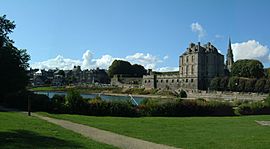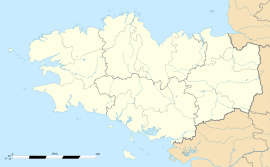Quintin facts for kids
Quick facts for kids
Quintin
|
||
|---|---|---|

The lake and chateau of Quintin
|
||
|
||
| Country | France | |
| Region | Brittany | |
| Department | Côtes-d'Armor | |
| Arrondissement | Saint-Brieuc | |
| Canton | Plélo | |
| Intercommunality | Pays de Quintin | |
| Area
1
|
3.12 km2 (1.20 sq mi) | |
| Population
(Jan. 2021)
|
Lua error in Module:Wd at line 1,575: attempt to index field 'wikibase' (a nil value). | |
| Time zone | UTC+01:00 (CET) | |
| • Summer (DST) | UTC+02:00 (CEST) | |
| INSEE/Postal code |
22262 /22800
|
|
| Elevation | 154–220 m (505–722 ft) | |
| 1 French Land Register data, which excludes lakes, ponds, glaciers > 1 km2 (0.386 sq mi or 247 acres) and river estuaries. | ||
Quintin (in Breton: Kintin) is a charming town in the Côtes-d'Armor area of the Brittany region. You can find it in the northwest of France, about 16 kilometers (10 miles) from Saint-Brieuc, which is the capital city of the department.
Contents
Exploring the History of Quintin
The area around Quintin has been home to people for a very long time. We know this because tools and signs of life from the Neolithic period (the New Stone Age) have been found here.
How Quintin Moved and Grew
The first version of Quintin was actually located near a place called Vieux-Bourg. But after a serious sickness, like a plague epidemic, spread through the area, the town moved to where it is today.
In Roman times, Quintin was an important spot because it was located at a crossroads. This meant many paths met there. The town really started to grow a lot in the 1600s and 1700s.
The Rise and Fall of the Weaving Industry
Quintin became famous for its weaving industry. People here made a lot of linen cloth and traded it. At its busiest time, Quintin had about 300 weavers working!
However, things changed with the French Revolution (a big historical event in France). Also, cotton started to become more popular than linen. This caused the weaving industry in Quintin to decline.
Quintin's Past Importance
Quintin was also a center for monks and religious life. Even today, you can see many old buildings and grand houses that show how important the city once was.
Sadly, the French Revolution and earlier religious wars caused a lot of damage. They left many parts of the old medieval city in ruins.
Language in Quintin's Past
In 1843, a book about the geography and history of Brittany mentioned something interesting. It said that the people living in Quintin spoke both French and Breton. This shows the mix of cultures in the area.
Images for kids
See also
 In Spanish: Quintin para niños
In Spanish: Quintin para niños







